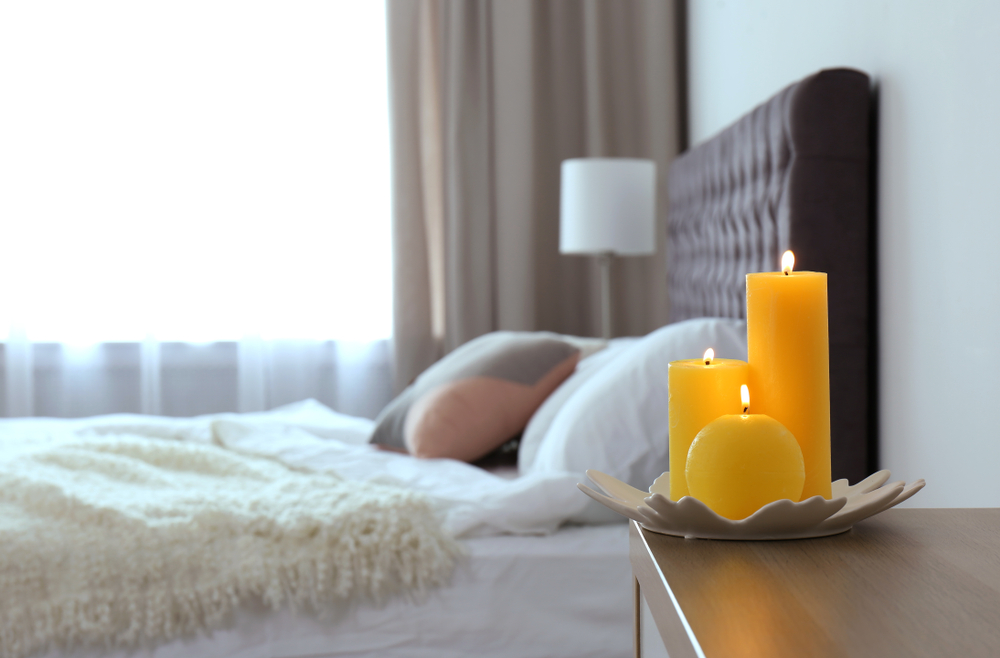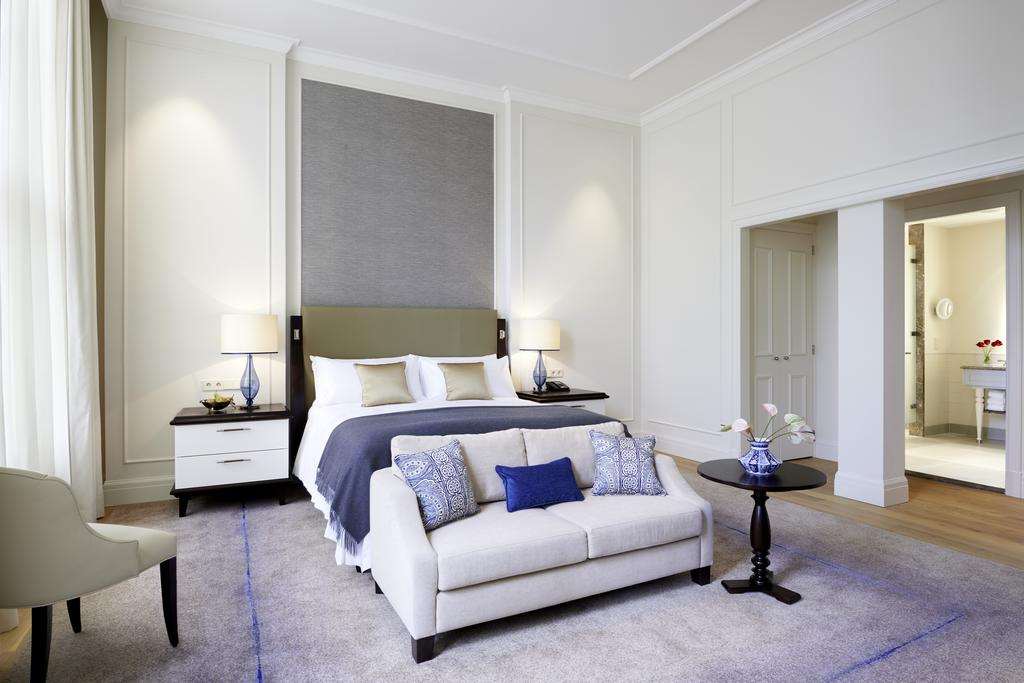Creating a serene, relaxing bedroom is essential for fostering restful sleep, recharging your energy, and maintaining a positive mindset. A harmonious bedroom designed with serenity in mind can make a profound difference in your overall wellbeing, especially when you incorporate layout techniques and Feng Shui principles. Here’s a guide on how to design the ultimate tranquility filled bedroom.

How To Use Feng Shui For The Most Relaxing Serenity Bedroom
1. Choosing a Soothing Colour Palette
The colours in your bedroom set the tone for relaxation. Soft, muted tones are best for creating a calming atmosphere, with colours like soft greys, blues, greens, and creams being excellent choices for evoking a sense of serenity. These shades are associated with peace and balance, encouraging rest and mindfulness. Avoid overly bright or stimulating colours, which can disrupt the calming ambiance.
Feng Shui Tip – In Feng Shui, blue represents peace, while earthy tones like beige and light brown promote stability. If you’re unsure which colours to use, consider introducing elements of blue and earth tones to ground the room’s energy.
2. Positioning the Bed for Maximum Comfort
The bed is the heart of any bedroom, and its position is crucial in creating a balanced, restful environment. Place the bed in a way that offers a full view of the room while creating a sense of protection and comfort.
Feng Shui Tip – According to Feng Shui, position the bed in the “command position”, this means the headboard is against a solid wall, but the bed itself should not directly face the door. Ideally, you should have a clear view of the door without being in direct line with it, as this enhances security and peace.

3. Selecting Furniture with Clean Lines
To maintain a clutter free, calming space, choose minimalistic furniture with simple lines and neutral colours. Opt for essential pieces, like a bed, nightstands, and perhaps a single chest of drawers or a small wardrobe, to avoid overcrowding.
Feng Shui Tip – Ensure your furniture edges aren’t too sharp or angular, as sharp lines can disrupt the energy flow. Instead, choose furniture with rounded edges where possible, as this promotes a smoother, calmer energy.
4. Declutter for Peace of Mind
Clutter can be a significant source of stress, even if you’re not always consciously aware of it. A clutter free room creates a sense of order, making it easier to relax. Keep surfaces, such as nightstands and dressers, as clear as possible, and incorporate clever storage solutions to keep items out of sight.
Feng Shui Tip – Clutter represents stagnant energy, so regularly clearing out unnecessary items can improve energy flow and bring fresh, calming vibes to the room. Keep the area under your bed clear as well, as storing items here can disrupt restful sleep.
5. Incorporate Natural Elements
Bringing nature into the bedroom fosters a connection to the natural world, promoting relaxation and mental clarity. Add elements such as plants, natural wood furniture, or a small water feature like a tabletop fountain. Indoor plants such as peace lilies, snake plants, or lavender not only improve air quality but also create a natural calming effect.
Feng Shui Tip – In Feng Shui, plants represent life energy, growth, and renewal. Place them in areas where they won’t obstruct movement or energy flow, like in a corner or near a window. However, avoid placing plants too close to the bed, as they can create a sense of busyness rather than calm.
6. Lighting to Enhance the Mood
Lighting plays a significant role in setting the tone of a room. Incorporate layered lighting options, such as a central fixture with dimmer capabilities, bedside lamps, and perhaps a few candles for a softer glow. Avoid overly bright or harsh lighting, as it can disrupt the serene atmosphere.
Feng Shui Tip – Natural light is highly beneficial, so try to maximise daylight by keeping windows unobstructed. In the evening, use warm toned lights to create a cozy, relaxing vibe. Soft lighting is especially important in Feng Shui, as it helps balance the room’s energy, promoting peace.
7. Adding Soft Textures for Comfort
Soft, tactile fabrics bring an element of comfort that encourages relaxation. Choose plush bedding, such as high thread count sheets, a comfortable duvet, and a selection of pillows. Consider adding a soft rug underfoot, which adds warmth and coziness.
Feng Shui Tip – In Feng Shui, soft textures represent a nurturing energy that invites rest and relaxation. Layering different textures, such as a woolen throw, cotton sheets, and a velvet pillow, helps add depth and balance to the room, making it more inviting and comforting.

8. Using Scent to Create a Calming Atmosphere
Scent is a powerful tool for setting a tranquil atmosphere in your bedroom. Choose natural, relaxing scents like lavender, chamomile, or eucalyptus, which are known for their calming properties. Use a diffuser, room spray, or candle to release these fragrances in the room.
Feng Shui Tip – Scent can help to cleanse and balance a space. In Feng Shui, certain scents are used to harmonise energy. Lavender, for instance, is ideal for relaxation and can aid restful sleep, while jasmine is uplifting and helps create a positive, peaceful environment.
9. Minimising Electronic Distractions
To achieve true serenity, keep electronics to a minimum in the bedroom. Phones, TVs, and computers can all disrupt sleep and relaxation, so consider designating your bedroom as a tech-free zone. If you need an alarm, opt for a traditional alarm clock rather than relying on your phone.
Feng Shui Tip – Electronics emit energy that can interfere with your relaxation and disrupt sleep, creating an atmosphere of restlessness. Keep electronics away from the bed or, better yet, outside the bedroom entirely to promote a peaceful, rejuvenating environment.
10. Creating Balanced and Symmetrical Layouts
A balanced layout is visually calming and promotes a harmonious energy flow. Arrange furniture symmetrically where possible, such as placing identical nightstands on either side of the bed or matching lamps for balance. Avoid overcrowding the room, and create pathways that allow easy movement around the space.
Feng Shui Tip – In Feng Shui, balance and symmetry are believed to enhance harmony in a space. For instance, if you share the bedroom with a partner, symmetrical arrangements symbolise balance and equality, contributing to a more peaceful and supportive environment.
Bringing It All Together
Creating a serene and relaxing bedroom is about bringing harmony to your space in a way that resonates with your personal sense of peace and tranquillity. By thoughtfully arranging furniture, choosing soothing colours and textures, and minimising distractions, you can transform your bedroom into a sanctuary for relaxation and renewal.
Incorporating Feng Shui principles, such as placing the bed in a command position, minimising clutter, and using balanced layouts, further enhances the peaceful atmosphere, creating a balanced and harmonious space.
A well-designed serenity bedroom will support restful sleep and allow you to unwind at the end of each day, making it an invaluable retreat from the stresses of daily life. Whether through subtle colour choices, carefully chosen furniture, or a few lush plants, every detail should contribute to a room that promotes calm, comfort, and complete relaxation.
